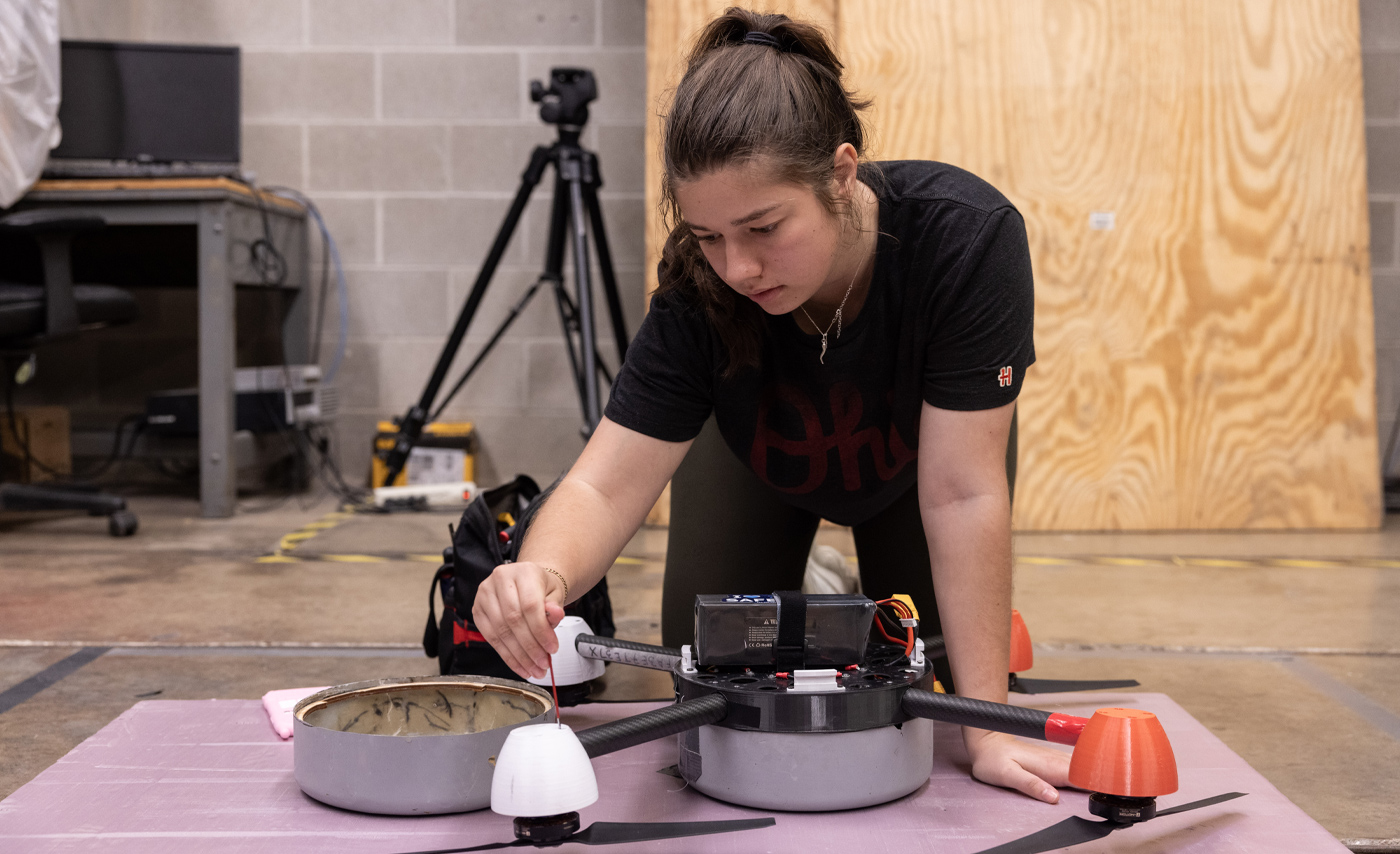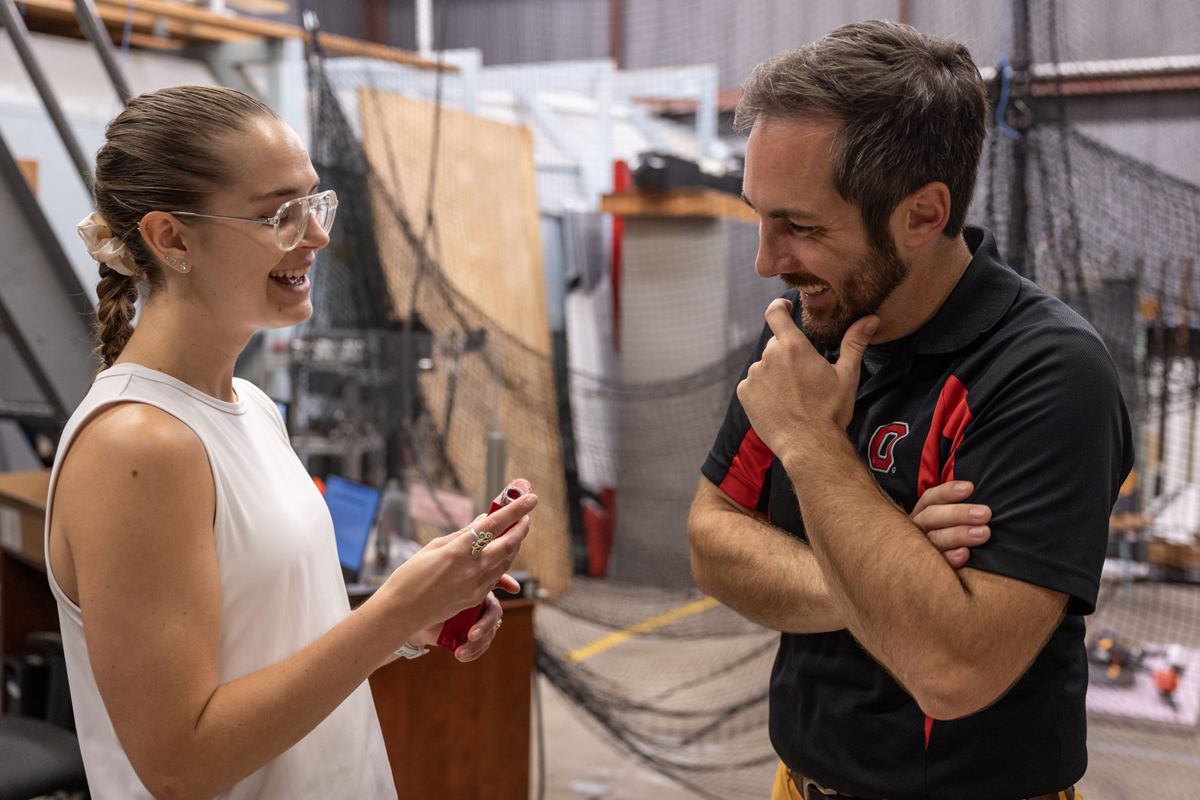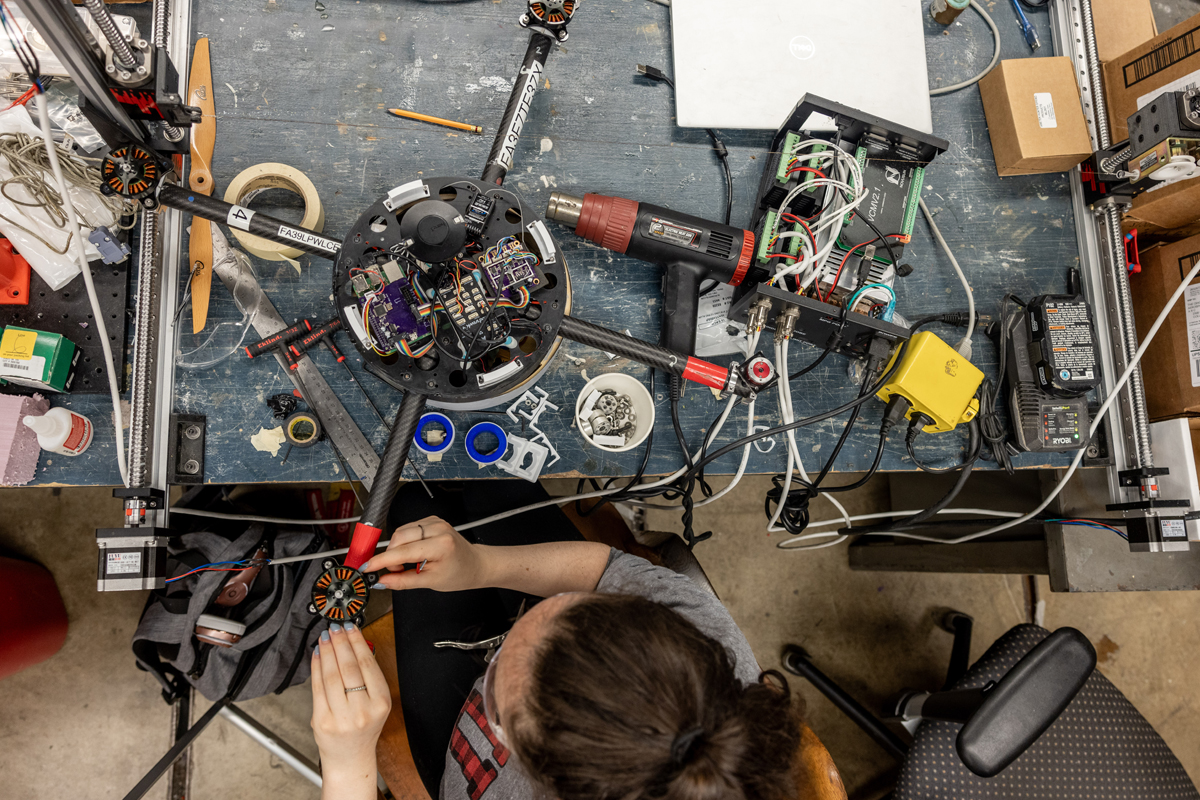Elevating drone tech while maintaining safe airspaces
Matt McCrink’s research lab is creating the next generation of drone tech, while writing the protocols that keep our airspaces safe.

Sanding and buzzing and typing and chatter fills the air.
In one room, students are sanding propeller rotor blades smooth, in another a test drone buzzes upon liftoff, hovers for a demonstration.
The setting is an old school shop class meeting a high-tech playroom as large, open spaces with desks and benches are populated by students tapping on laptops or twisting screwdrivers to tweak their drones, or uncrewed aerial vehicles (UAVs).
This is Matt McCrink’s drone lab, a hub for a variety of UAV projects that take him and his students to collaborations near and far, researching how to perfect drone technology while creating the regulations that will keep our airspaces safe.
“We’re maturing drones toward making them efficient, safe vehicles for operation in the national airspace,” says McCrink ’15 PhD, assistant professor of mechanical and aerospace engineering. “If we are going to fly drones to deliver shoes or whatever it may be, we need to understand the limits of where and how they can fly, so we’re always looking at defining those safe operating characteristics.”
Since creating his lab, McCrink has worked hand in hand with researchers across Ohio State’s campus and the country on a myriad of projects that are making drones better while ensuring safe airways.

“We see our lab as fundamental to flight test,” he says. “From getting into the weeds of how rotor blades work then asking bigger questions of what happens when they go out and we can’t see them, developing those systems, then building to the point we can fly these outside with other low flying vehicles safely. Then, how do we do it on another planet? That’s how we’ve set ourselves up here.”
This list provides a highlight reel sampling of past and ongoing projects from McCrink’s lab that are helping perfect drone technology and safety:
Rotorcraft dynamics: McCrink’s lab is applying aerospace analysis techniques to typical drones to improve the efficiency and safety of how they operate in the national airspace. That can include how the rotors interact with the fuselage or how the airflow of the propellers causes the craft to react as it gets near walls, an especially important concept as UAVs begin to fly close to city buildings or, one day, air taxis fly us around those urban environments.

Autonomous flight: A major goal of everyone in the drone space — from Amazon for product delivery to drones for first response — is autonomous flight systems, giving us the ability to program a destination and let the drone do the work. However, it’s notoriously tricky and McCrink’s lab is working diligently to perfect the capabilities. In fact, one of his creations set a world speed record while flying autonomously for 28 miles, averaging speeds of 147 mph, a major step in the right direction.
Cadaver study: Many of the Federal Aviation Administration (FAA) regulations around drone safety came from a study McCrink did with Ohio State’s John Bolte and his cadaver lab. The study tested what happens to a human body if drones of varying weights and sizes fall out of the sky and hit someone. Those safety regulations become increasingly important for situations like sporting events or during news coverage, when drones are used for photos and video, or even as we see more UAVs delivering packages to doorsteps.
Uncrewed Traffic Management system: Since 2018, McCrink has been working with a number of government institutions — from the Ohio Department of Transportation to the FAA — to create an Uncrewed Traffic Management system to keep the skies safe for low altitude flying objects, such as drones, medical helicopters and crop dusting planes. This system is a first for an urban environment and uses radars located around central Ohio in tandem with protocols in which pilots request clearance to fly, creating safe airspaces for our cities.
Active flow control: McCrink’s lab is working with other Ohio State researchers to create active flow control on airplanes. Essentially, it means no moving parts on planes, such as the wings, which allows for dramatically improved efficiency, even stealth, creating more aerodynamic vehicles that use less fuel, are quieter and are even smaller.

Drones on Mars: Since 2021, NASA’s Ingenuity helicopter drone has completed 60 flights, an impressive feat in the extremely thin atmosphere. McCrink’s lab is developing better blades to support heavier payloads in the extremely thin air environment of Mars. He hopes to partner with NASA to improve flight times and capabilities, such as scanning the planet vastly quicker than rovers.
(Bonus) The student experience: McCrink’s students often build every piece of their drones in-house and from scratch, allowing them to understand the intricacies of UAVs. They’re also heavily involved in his projects and their own. When his students leave? They find incredible opportunities. For instance: One of his students, Adithya Ramaswami, who started the Buckeye Vertical drone team that competes, and wins, nationally, co-founded ParaWave, a company working to create drones to assist firefighters and first responders.